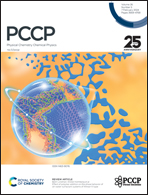A first-principles study of electro-catalytic reduction of CO2 on transition metal-doped stanene†
Abstract
Employing first-principles calculations based on density functional theory, this work examines the activity of 3d transition metal-doped stanene for electro-catalytic CO2 reduction through the first two electron transfer steps to CO. Our results related to CO2 activation, the first and a crucial step of the reduction process revealed that, among the entire 3d transition metal row studied, only Ti- and Fe-doped stanene can bind and significantly activate the CO2 molecule, while the rest of the TM single atoms are inert in activating the molecule. The activation of the CO2 molecule on Ti- and Fe-doped stanene has been observed in the presence of water as well. In addition, the formation of OCHO has been observed to be energetically preferred over COOH formation as a reaction intermediate, indicating the preference for the formate path of the reduction reaction. Furthermore, despite the strong adsorption of H2O on the catalyst surface, the presence of water seems to enhance CO2 adsorption on the catalysts, contrary to what has been observed recently in graphene-based catalysts. Finally, our difference charge density and the Bader charge calculations reveal that the ability of Ti- and Fe-doped stanene in activating the CO2 molecule and their potential catalytic activity for CO2 reduction is to be attributed to the charge transfer between the catalyst and the molecule, providing new insights into the rational design of 2D catalysts beyond graphene.

- This article is part of the themed collection: Celebrating International Women’s day 2025: Women in physical chemistry


 Please wait while we load your content...
Please wait while we load your content...